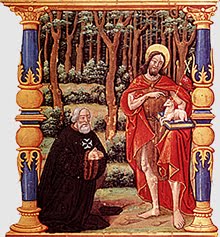In addition to being the transferred feast of the Ascension of Our Blessed Lord, and that, in some calendars, of Saint Augustine of Canterbury, he who found the English to be both pious and comely, a challenge to which we should well to try to live up, however difficult, today is also the feast of one of the great female saints out our beloved Order, Ubaldesca.
 |
Window at
Saint John's Gate
London |
She was born in 1136 at Calcinia, near Pisa. At the age of fifteen, she joined the Order of Saint John of Jerusalem, and worked for fifty-five years in the infirmary attached to the monastery at Pisa, caring for her neighbour out of love for God.
Her parents, humble and simple farmers, were Godfearing people and good Christians; they taught her obedience and the love of silence which they themselves practiced. She was trained early to work at her household tasks and to pray constantly. She already macerated her poor little body and had resolved never to refuse the requests of the unfortunate. She gave them what she could and, when she had nothing to give, she offered at least the consolation of her smile, paying close attention to the tale of the troubles of each with fraternal understanding. No one left her without being comforted.
She soon understood the gravity of life and wondered what form hers should take to please God; she implored Him for guidance. At the age of fourteen, one day as she was baking the family's bread, she had the vision of an angel who ordered her to enter the convent of the Sisters of Saint John of Jerusalem. She was astonished, and said:
"But, I have no dowry. And my parents cannot give me any".
"The mothers have not so much need for dowries as for virtues", replied the angel.
Ubaldesca smiled. "But what if I have no virtues?".
And the angel in the same tone of voice: "The Holy Ghost will supply".
The messenger of God disappeared, and the girl, forgetting the oven and the bread in it, ran off to the fields where her parents were at work to tell them what had happened and to ask their permission to go away. Without more reflection or delay, the three left for the convent of St. John of the Temple of Carraia in Pisa.
Forewarned by the angel, the abbess and her forty cloistered nuns stood behind the door of the enclosure to wait for the postulant who was received as soon as she knocked. They went to the church where Ubaldesca immediately received the red gown and black cloak in the presence of her parents who wept with joy and sorrow and who returned home after having seen the doors of the convent close on their only daughter.
The next day, their supply of bread being exhausted, they remembered the bread in the oven, and not without irritation. They believed it to be completely charred. But, on removing the stone of the oven, they found the bread baked to perfection and as golden as never before. Not believing their eyes, they took it to the sisters, as a token of thanksgiving and a proof of the miracle.
Ubaldesca died on 28 May 1206. Her body was taken back to Calcinia where it is now enshrined. Not only honoured among the saints and blessed of the Order of Saint John of Jerusalem, she is celebrated also as a patroness of the City of Pisa.
Collect of the Mass
O God, pride of the humble and lover of virginity,
you called Saint Ubaldesca to the religious life
in the Order of Saint John of Jerusalem :
Grant that through her prayers and example
we may rejoice in being humble
and follow you with pure minds.
We ask this through our Lord Jesus Christ your Son,
who lives and reigns with you and the Holy Spirit,
one God, for ever and ever.
Amen.
















